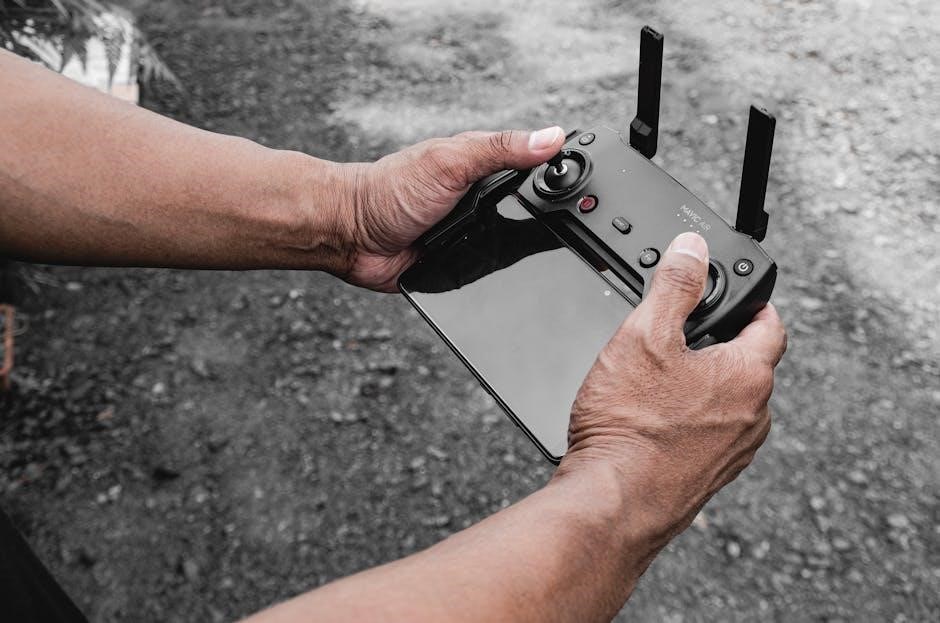This manual provides a comprehensive guide to the Eliwell controller‚ covering installation‚ programming‚ and troubleshooting. It ensures optimal performance and is designed for users seeking efficiency and control.
Overview of the Eliwell Controller
The Eliwell controller is a sophisticated device designed for precise temperature regulation and advanced system control. It features a user-friendly interface with multi-function keys‚ enabling easy navigation through parameters and settings. The controller supports modulating defrost control‚ ensuring efficient operation in cooling systems. It also offers remote access and cloud connectivity‚ allowing users to monitor and adjust settings remotely. Designed for versatility‚ the Eliwell controller is suitable for various applications‚ including refrigeration units and air treatment systems. Its compact design and panel-mounting capability make it ideal for installation in diverse environments. The device is equipped with relay outputs‚ temperature sensors‚ and digital inputs‚ providing comprehensive control over connected systems. Regular updates and firmware improvements ensure optimal performance and adaptability to evolving user needs.
Importance of the Manual for Users

Importance of the Manual for Users
This manual is an essential resource for understanding and maximizing the potential of the Eliwell controller. It provides detailed guidance on installation‚ operation‚ and troubleshooting‚ ensuring users can safely and effectively utilize the device. The manual covers critical safety information‚ initial setup procedures‚ and advanced features like remote access and parameter configuration. By following the instructions‚ users can avoid potential errors and ensure optimal performance. Additionally‚ the manual serves as a reference for resolving common issues and performing routine maintenance. Whether you’re a novice or an experienced user‚ this guide empowers you to harness the controller’s full capabilities‚ ensuring efficient and reliable operation in various applications.
Safety Information and Precautions
Safety Information and Precautions
Reading this manual carefully is crucial to ensure safe and proper use of the Eliwell controller. Before installation or operation‚ visually inspect the device for damage. Always disconnect power before performing any maintenance or repairs. Avoid unauthorized modifications‚ as they may void the warranty or compromise safety. Follow all electrical safety guidelines‚ including proper grounding and wiring. Do not expose the controller to extreme temperatures‚ moisture‚ or corrosive environments. Use protective equipment when handling electrical components. Ensure the controller is mounted securely to prevent mechanical stress. Never touch internal components without proper insulation. Adhere to all precautions outlined in the manual to prevent accidents and ensure reliable operation. Failure to comply may result in damage to the device or pose risks to user safety.

Installation and Mounting Guidelines
Install the Eliwell controller by drilling a 29×71 mm hole‚ securing it with provided brackets. Disconnect power before handling and ensure proper grounding for safety.
Panel Mounting Instructions
For panel mounting‚ drill a 29×71 mm hole in the desired location. Insert the controller into the hole and secure it using the provided mounting brackets. Ensure the device is level and firmly attached to the panel. Before handling‚ disconnect power to avoid electrical hazards. Use the correct tools to prevent damage to the controller or panel. Verify proper alignment to maintain functionality and aesthetics. Follow safety guidelines to ensure a stable and secure installation. This method ensures optimal performance and accessibility of the controller. Refer to the manual for detailed diagrams or additional guidance if needed.
Drilling and Securing the Controller
To drill and secure the Eliwell controller‚ start by marking the panel at the desired mounting location. Drill a hole with dimensions of 29×71 mm to accommodate the controller. Ensure the hole is precise to avoid damaging the device. Insert the controller into the hole‚ aligning it properly. Use the provided mounting brackets to secure the device firmly to the panel. Tighten the screws gradually to avoid misalignment. Verify that the controller is level and stable after installation. If necessary‚ adjust the position to achieve proper alignment. Once secured‚ test the controller’s stability by gently tugging on it. Proper drilling and securing ensure safe and reliable operation of the device. Always disconnect power before performing these steps to prevent electrical hazards.
Initial Setup and Power-On Procedure
Begin by ensuring the controller is properly mounted and all connections are secure. Disconnect power before starting the setup. Once powered on‚ press and hold the multifunction key to access the initial setup menu. Use the UP and DOWN keys to navigate through settings‚ configuring parameters as needed. After setup‚ press the set key to save changes. The controller will automatically restart to apply the new configurations. Ensure all safety precautions are followed‚ such as disconnecting power before any manual adjustments. Refer to the parameter map for specific settings and ensure they align with your application requirements. Proper initialization ensures optimal performance and prevents operational errors. Always verify settings after power-on to confirm correct operation.

Programming and Configuration
Access the machine status menu by pressing the set key. Navigate through parameters using the UP and DOWN keys. Adjust settings as needed and save configurations properly.
Accessing the Machine Status Menu

To access the machine status menu‚ press and release the set key. Use the UP and DOWN keys to scroll through the menu options. Ensure all parameters are properly validated before saving. Note that modifying parameters marked with (!) requires a system restart for correct operation. Always refer to the manual for specific instructions to avoid configuration errors. This menu provides essential insights into the controller’s functioning‚ allowing for precise adjustments and monitoring. Proper navigation ensures efficient setup and troubleshooting‚ optimizing the controller’s performance. Follow the on-screen prompts carefully to achieve desired settings and maintain system stability.
Navigating Through Parameters and Settings
Navigating through the Eliwell controller’s parameters and settings is straightforward using the multi-function key and navigation buttons. Press the set key to enter the menu‚ then use the UP and DOWN keys to scroll through options; Select a parameter by pressing the set key again‚ and adjust values using the same keys. Validate changes by pressing the set key once more to save. Some parameters may require additional confirmation or system restarts to take effect. Always ensure settings are validated correctly to maintain optimal operation. Refer to the manual for specific instructions on advanced parameters and configurations. Proper navigation ensures precise control over the controller’s functions‚ enhancing efficiency and performance. Follow on-screen prompts carefully to avoid errors and achieve desired configurations.
Downloading and Uploading Parameter Maps

Downloading and uploading parameter maps on the Eliwell controller is a streamlined process using the multi-function key and a Copy Card. To download parameters‚ insert the Copy Card‚ navigate to the download option in the menu‚ and press the set key. The controller will transfer the current settings to the card. For uploading‚ insert the card‚ select the upload option‚ and confirm. The controller will apply the new settings. After uploading‚ some parameters may require a system restart to take effect. Always validate changes to ensure proper operation. Refer to the manual for detailed instructions to avoid errors during the process. This feature allows easy configuration backup and transfer‚ enhancing flexibility and efficiency in managing the controller’s operations. Proper use of this function ensures consistent performance and customization of settings.

Advanced Features of the Eliwell Controller
The Eliwell controller offers advanced features like modulating defrost control‚ multi-function key operations‚ and remote access‚ ensuring enhanced performance and customization for precise temperature management.
Modulating Defrost Control
The Eliwell controller features a modulating defrost control system designed to optimize refrigeration efficiency; This advanced function dynamically adjusts defrost cycles based on evaporator conditions‚ reducing unnecessary defrost operations and minimizing frost buildup. By precisely managing defrost timing and duration‚ the system ensures consistent temperature levels and prevents energy waste. The modulating defrost control integrates seamlessly with the controller’s temperature regulation algorithms‚ providing adaptive responses to changing operating conditions. This feature is particularly beneficial in applications where maintaining precise temperature control is critical. The system also reduces wear on compressors and evaporator coils by avoiding excessive defrost cycles. Overall‚ the modulating defrost control enhances system performance‚ reliability‚ and energy efficiency‚ making it a key advantage of the Eliwell controller.
Multi-Function Key Operations
The multi-function key on the Eliwell controller streamlines operations by enabling quick access to advanced features. It allows users to download and upload parameter maps‚ navigate through menus‚ and perform specific functions efficiently. By pressing and holding the key‚ users can access specialized settings‚ such as defrost control parameters or communication configurations. This feature enhances user convenience‚ reducing the time needed to configure and monitor the controller; The multi-function key also supports parameter copying between devices‚ ensuring consistency across multiple units. Its intuitive design makes it easier to perform complex tasks without extensive manual navigation‚ improving overall system management. Refer to the manual for detailed instructions on utilizing the multi-function key for specific operations.
Remote Access and Cloud Connectivity
Remote access and cloud connectivity features on the Eliwell controller enable seamless monitoring and management of your system from anywhere. Using the TelevisAir app‚ users can access real-time data‚ adjust settings‚ and receive notifications. Cloud integration allows for centralized control of multiple units‚ ensuring optimal performance and energy efficiency. The controller supports secure communication protocols‚ safeguarding your data. Firmware updates can be remotely downloaded‚ keeping your system up-to-date with the latest features. Additionally‚ cloud connectivity facilitates data logging and analysis‚ helping you make informed decisions. This feature is particularly useful for large-scale applications‚ where remote management enhances operational efficiency. Refer to the manual for detailed instructions on setting up and utilizing remote access and cloud connectivity options.

Troubleshooting Common Issues
This section helps users identify and resolve common issues with the Eliwell controller‚ covering parameter conflicts‚ communication errors‚ and system malfunctions‚ ensuring smooth operation and minimal downtime.
Identifying and Resolving Parameter Conflicts
Parameter conflicts occur when settings mismatch‚ causing malfunctions. Use the machine status menu to review parameters and identify discrepancies. Press and release the set key to access the menu‚ then navigate with the UP and DOWN keys. If conflicts arise‚ modify parameters to align with system requirements. After adjustments‚ switch the controller off and on to ensure correct operation. The multi-function key aids in downloading or uploading parameter maps‚ resolving conflicts efficiently. Regular checks prevent issues‚ while detailed logs help trace problems. Addressing parameter conflicts promptly ensures stability and optimal performance‚ avoiding system instability or errors. Refer to the manual for specific guidance or contact support for unresolved issues.
Rebooting and Resetting the Controller
Rebooting the Eliwell controller is essential after parameter modifications to ensure proper operation. To reboot‚ switch the controller off and then on again. This process refreshes settings and prevents malfunctions. For a factory reset‚ press and hold the set key while powering on‚ then release it after three seconds. This restores default settings but may require reconfiguring parameters. Regular reboots help maintain stability‚ especially after updates or parameter changes. Always power down before performing physical resets or disconnecting power. Resetting can resolve software glitches without affecting saved configurations. Use the machine status menu to monitor system health and address issues promptly. Rebooting is a simple yet effective way to maintain optimal performance and reliability.
Addressing Communication Errors
Communication errors can occur due to faulty connections or software glitches. Ensure all cables are securely connected and power cycle the controller if issues persist. Check network settings to confirm the controller is on the same network as other devices. Verify that the latest firmware is installed‚ as outdated versions may cause compatibility issues. If using wireless communication‚ ensure there are no physical obstructions interfering with the signal. Review the error logs to identify specific issues and refer to the troubleshooting guide for detailed solutions. Resetting the controller or reinstalling drivers may resolve connectivity problems. If errors continue‚ contact Eliwell support for advanced assistance. Regular updates and proper configuration are key to maintaining reliable communication.

Maintenance and Updates
Regular maintenance ensures optimal performance. Perform routine checks‚ clean components‚ and update firmware. Back up configurations to prevent data loss and ensure system reliability.
Routine Checks and Cleaning
Regular maintenance is essential for optimal performance. Users should perform routine checks to ensure all components function correctly. Clean the controller’s display and external surfaces with a soft cloth and mild detergent. Avoid harsh chemicals that may damage the device. Internal components should be inspected for dust buildup‚ which can be removed using compressed air. Ensure proper ventilation around the controller to prevent overheating. Check connections and wiring for any signs of wear or damage. Perform these tasks periodically‚ as outlined in the manual‚ to maintain reliability and extend the lifespan of the device. Regular cleaning and inspections help prevent unexpected issues and ensure accurate temperature regulation.
Updating Firmware and Software
Updating the firmware and software of your Eliwell controller is crucial for ensuring optimal performance and accessing new features; Regularly check the Eliwell website for the latest versions. Downloads are available after registration‚ typically requiring a Copy Card for parameter updates. Use the Multi-Function Key to initiate the upload process. Ensure the controller is powered on and connected during updates. Follow the manual’s step-by-step instructions to avoid errors. After completing the update‚ restart the controller to apply changes. Always verify the success of the update in the machine status menu. Keeping the firmware and software up-to-date enhances functionality‚ security‚ and compatibility. Never skip this step‚ as outdated versions may lead to operational issues or reduced efficiency.
Backing Up Configuration Settings

Backing up your Eliwell controller’s configuration settings is essential to prevent data loss and ensure quick recovery in case of system resets or failures. Use the Multi-Function Key to access the backup option in the machine status menu. Select “Parameter Upload” to transfer settings to a Copy Card or external device. Insert the Copy Card‚ confirm the operation‚ and wait for the upload to complete. Regular backups are recommended‚ especially after configuring or updating parameters. Store backup files securely to maintain system integrity. This process ensures that custom settings are preserved‚ reducing downtime and simplifying troubleshooting. Always verify the backup’s success before proceeding with any further operations or updates.
Thank you for referring to this manual. By following the guidelines‚ you ensure optimal performance and efficient troubleshooting of your Eliwell controller. Refer to this manual for future reference.
Final Tips for Optimal Performance
For optimal performance‚ ensure regular maintenance‚ including cleaning and updating firmware. Always back up configurations before making changes. Use the multi-function key for efficient parameter management. Regularly check sensor accuracy and connections. Refer to the manual for detailed troubleshooting steps and advanced features. Ensure all safety precautions are followed during installation and operation. Maintain proper communication settings to avoid errors. By following these guidelines‚ you can maximize the efficiency and reliability of your Eliwell controller. Consult the manual for specific instructions and detailed procedures to ensure uninterrupted operation and optimal results.
Resources for Further Assistance
For detailed guidance‚ refer to the official Eliwell controller manual available on their website. Additional resources include the TelevisAir APP & Cloud User Guide‚ which covers advanced features. The manual emphasizes that all contents are proprietary to Eliwell Controls SRL and should not be redistributed without permission. Technical support is available through their official contact channels for unresolved issues. Users can also access parameter configuration guides and troubleshooting tips online. Ensure to download updates and manuals from authorized sources to maintain compliance. Regularly visit the Eliwell website for the latest firmware and software updates. By utilizing these resources‚ users can maximize their understanding and efficiency with the controller.